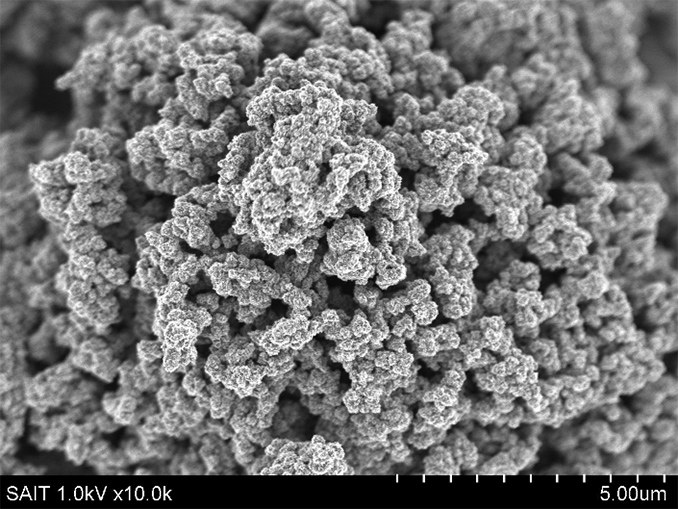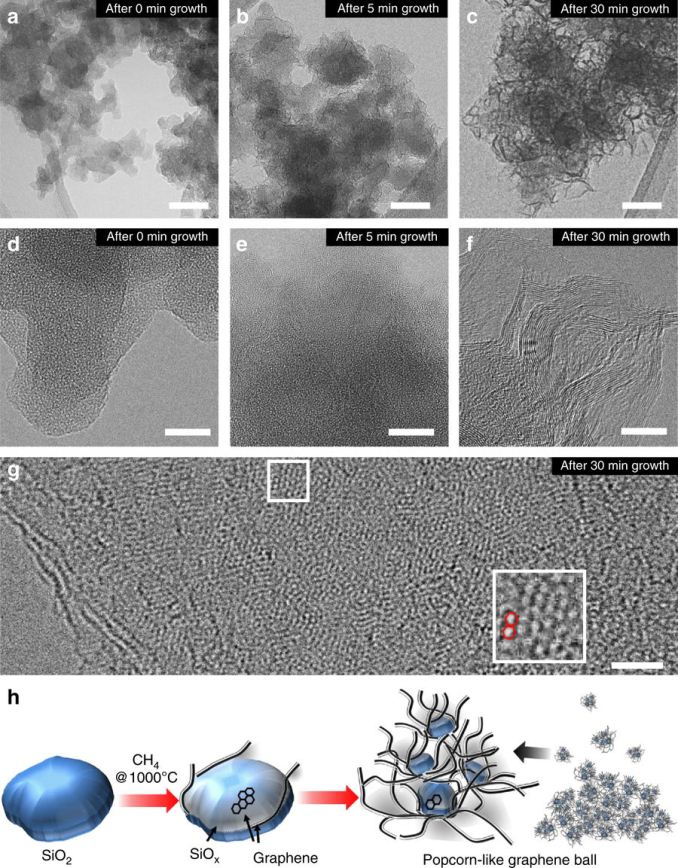Samsung’s Reveals Li-Ion Battery with Graphene Balls: Higher Capacity, Faster Charging
by Anton Shilov on November 29, 2017 5:00 PM EST- Posted in
- Mobile
- Samsung
- Battery
- Samsung SDI
- Graphene

Samsung on Tuesday announced that it had developed a way to improve Lithium-Ion batteries with its new material called graphene balls. The company says that batteries featuring the new material charge five times faster than conventional Lithium-ion accumulators and enable a considerably higher volumetric energy density.
The new battery technology developed by Samsung SDI and its partners* uses the so-called graphene balls (a 3D structure synthesized from silicon dioxide, Si02) to cover a cathode and also as an anode material. Graphene balls on the cathode suppress damaging side reactions while also providing efficient conductive pathways. This enables faster charging (as graphene features 140 times faster electron mobility than silicon) and increases the number of cycles a cell can withstand. According to Samsung, a battery cell featuring graphene balls has a 27.6% higher volumetric energy density compared to a similar cell without graphene balls. Furthermore, the cell also retains 78.6% of its capacity after 500 cycles at between 5°C and 60°C.
Samsung articulates that graphene balls could enable batteries with up to 45% higher capacities (than contemporary batteries) that can charge in 12 minutes – or five times faster than today’s batteries, as Samsung puts it. However, what Samsung is not saying when it intends to use the technology for commercial applications. Incorporation of a new protective layer for cathode and switching anode material changes battery production technology, which generally affects costs. Meanwhile, Samsung claims that the graphene ball material is not expensive to produce using its new chemical vapor deposition (CVD) process. To grow graphene around SiO2 nanoparticles with diameters of 20–30 nm, Samsung feeds them into a furnace and feds methane (CH4) into it at 1000°C.
“Our research enables mass synthesis of multifunctional composite material graphene at an affordable price,” said Dr. Son In-hyuk, who led the project on behalf of SAIT*. “At the same time, we were able to considerably enhance the capabilities of lithium-ion batteries in an environment where the markets for mobile devices and electric vehicles is growing rapidly. Our commitment is to continuously explore and develop secondary battery technology in light of these trends.”
Samsung expects to use its Li-ion batteries featuring graphene balls for electric vehicles and various mobile devices. Since the improved batteries can handle temperatures of around 60°C, they are a good fit for both applications. The most important question is of course when exactly Samsung SDI plans to commercialize them. To that end, it is noteworthy that earlier this year an unnamed executive from Samsung SDI told a newspaper that the company would be able to produce solid-state batteries for smartphones sometimes in 2019.
*The new battery technology was co-developed by Samsung SDI (the company’s battery arm), Samsung Advanced Institute of Technology (SAIT) as well as Seoul National University’s School of Chemical and Biological Engineering.
Related Reading:











45 Comments
View All Comments
iwod - Thursday, November 30, 2017 - link
If you read the actual paper in Nature rather then the press release, the tech is pretty much done and finished. Unlike other paper which were only used for hype and funding, Samsung doesn't need any of that.The paper also suggest while it could be used in small production, having it widely used in Cars or even Smartphone is an entirely different challenge. The production scale for these two type of product is massive.
galfert - Wednesday, November 29, 2017 - link
Yes, but do they explode?JoeyJoJo123 - Wednesday, November 29, 2017 - link
They have the capacity to explode with a "27.6% higher volumetric energy" than before.saratoga4 - Wednesday, November 29, 2017 - link
> Furthermore, the cell also retains 78.6% of its capacity after 500 cycles at between 5°C and 60°C.That isn't very good for a modern battery. 27% higher capacity isn't that much if it means that the cell is much less durable than a regular battery.
Sounds like they still have a lot more work to do.
JoeyJoJo123 - Wednesday, November 29, 2017 - link
I think that sentence implied that current batteries have worse retention of capacity after 500 cycles at between 5°C and 60°C, but the article doesn't elicit what those figures are for current non-graphene ball batteries. In other words, the 78.6% is supposedly an upgrade.And I guess with my cell phone being two years old or so by now seems about right. It seems to last about half the duration that it used to as far as I can tell, but I never did any empirical testing, and changing/upgrading of OSes has likely worsened its efficiency overall, too.
melgross - Wednesday, November 29, 2017 - link
I’m highly NOT impressed with the cycle life of these batteries. Apple already has their iPhone batteries rated at 500 cycles at 80%, and their watch and iPad batteries are far better, at 1,000 cycles.https://www.apple.com/batteries/service-and-recycl...
sonichedgehog360@yahoo.com - Wednesday, November 29, 2017 - link
Agreed. I noticed this figure and thought to myself, but my Surface Pro 2 was doing much in terms of retaining capacity after 1000 charge cycles!0iron - Wednesday, November 29, 2017 - link
But I don't recall any manufacture recommend to charge device up to 60°C, 40°C could be. It could be why Apple supplied slow charger with its iPhone, to reduce battery's wear rate.melgross - Wednesday, November 29, 2017 - link
It’s known that so called “fast chargers” shorten battery life, but you’ve only got your phone for two years, and, so what? But batteries can fail more quickly with some quick chargers. So far, Apple is allowing just 7.5 Watts with wireless. I don’t think it’s a quick charge thing, because I can charge my 7+ more quickly than that with my bigger Apple chargers.The quality of the battery plays a major part in that. Have a cheap battery, and it will die early. I didn’t read that they were saying that the charge could be to 60 c, but that it could get hot with use. Either way, there is no manufacturer that would allow their batteries get that hot. The device would be too hot to hold. Other components, particularly the screen, and double particularly OLED screens would get damaged.
0iron - Thursday, November 30, 2017 - link
"It’s known that so called “fast chargers” shorten battery life"It's believed but yet to find it's scientifically proven. 2 years life cycle maybe average. My usage minimum is 3 years then become secondary phone. It could be given to other family member after that. So, 5+ years of usage.